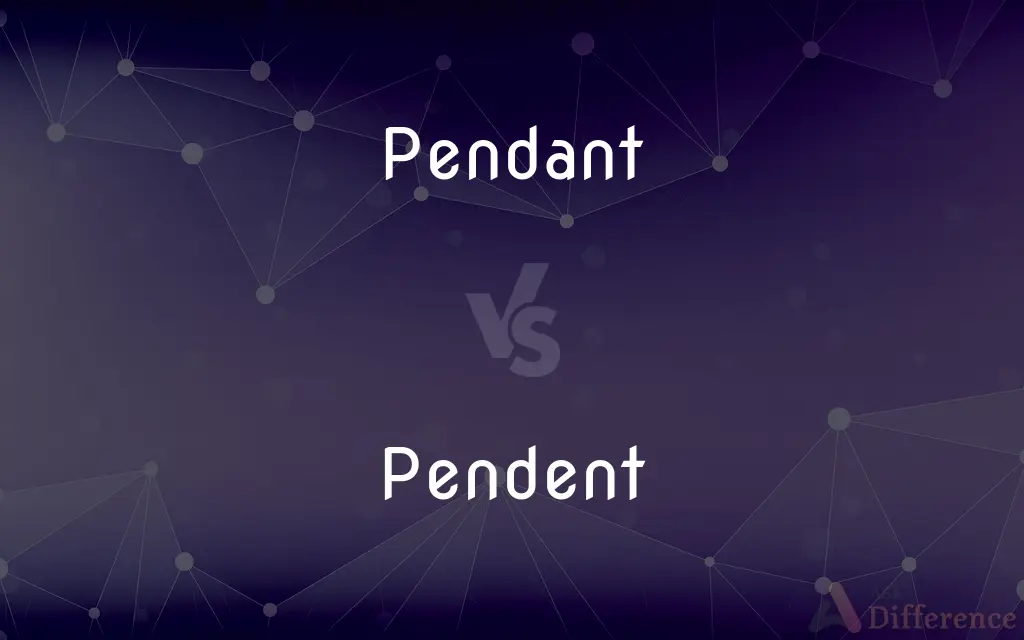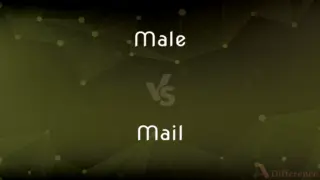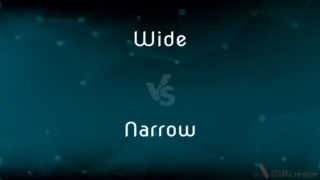Pendant vs. Pendent — What's the Difference?
Edited by Tayyaba Rehman — By Maham Liaqat — Updated on March 29, 2024
A pendant is a piece of jewelry that hangs from a chain worn around the neck, while "pendent" is an adjective describing something that is hanging or suspended.

Difference Between Pendant and Pendent
Table of Contents
ADVERTISEMENT
Key Differences
A pendant is often seen as a decorative item, a piece of jewelry designed to hang from a necklace or chain. It serves both aesthetic and sometimes functional purposes, such as holding a photograph, a locket, or even serving as a symbol of belief or affiliation. On the other hand, "pendent" is used to describe the state or condition of being suspended or hanging down from something. It does not refer to a specific item but rather to the characteristic of an object.
While "pendant" is primarily associated with jewelry, "pendent" can describe any object or feature that exhibits the quality of hanging. This distinction is key in understanding that "pendant" is a noun with a specific referent, and "pendent" is an adjective used to qualify the state of various objects.
The usage of "pendant" is quite specific and recognizable in everyday language, especially in the context of fashion and decoration. In contrast, "pendent" is more formal and less commonly used, typically found in specific contexts such as architecture, botany, or descriptive writing, where the nature of hanging is being highlighted.
Despite their differences, both terms share the same Latin root, "pendere," meaning to hang. This etymological connection underlines the shared concept of hanging that defines both terms, though they apply to different nouns and contexts.
Comparison Chart
Part of Speech
Noun
Adjective
ADVERTISEMENT
Definition
A piece of jewelry that hangs from a chain or cord.
Describing something that is hanging or suspended.
Usage Context
Fashion, jewelry, decoration.
Descriptive contexts, including botany, architecture.
Examples
A diamond pendant on a gold chain.
Pendent branches of a weeping willow.
Material/Form
Made from metals, gems, glass, etc.
Not applicable, as it describes a state.
Compare with Definitions
Pendant
Decorative and often symbolic jewelry.
The pendant represented her cultural heritage.
Pendent
Hanging down or suspended.
The pendent vines created a lush canopy.
Pendant
An ornament suspended from an object.
The chandelier had crystal pendants.
Pendent
In a state of suspension.
The decision was left in pendent after the meeting.
Pendant
A charm or amulet worn around the neck.
His pendant served as a protective talisman.
Pendent
Dangling or drooping.
Pendent earrings accentuated her features.
Pendant
A piece of jewelry hanging from a necklace.
She wore a pendant with her birthstone.
Pendent
Attached at the top, hanging freely.
The pendent lamp illuminated the room softly.
Pendant
An item designed to be hung.
The artist created a glass pendant for the exhibition.
Pendent
Pending or unresolved.
With matters still pendent, they postponed the closure.
Pendant
A pendant is a loose-hanging piece of jewellery, generally attached by a small loop to a necklace, which may be known as a "pendant necklace". A pendant earring is an earring with a piece hanging down.
Pendent
Pendent is an adjective that describes the condition of hanging, either literally, or figuratively, as in undecided or incomplete. To be distinguished from the spelling "pendant", which is the noun.
Pendant
Something suspended from something else, especially an ornament or piece of jewelry attached to a necklace or bracelet.
Pendent
Something suspended from something else, especially an ornament or piece of jewelry attached to a necklace or bracelet.
Pendant
A hanging lamp or chandelier.
Pendent
A hanging lamp or chandelier.
Pendant
A sculptured ornament suspended from a vaulted Gothic roof or ceiling.
Pendent
A sculptured ornament suspended from a vaulted Gothic roof or ceiling.
Pendant
One of a matched pair; a companion piece.
Pendent
One of a matched pair; a companion piece.
Pendant
Hanging down; dangling; suspended.
Pendent
Variant of pendant1.
Pendant
Projecting; overhanging.
Pendent
Hanging down; dangling; suspended.
Pendant
Awaiting settlement; pending.
Pendent
Projecting; overhanging.
Pendant
Variant of pendent1.
Pendent
Awaiting settlement; pending.
Pendant
(architecture) A supporting post attached to the main rafter.
Pendent
Dangling, drooping, hanging down or suspended.
Pendant
A piece of jewellery which hangs down as an ornament, especially worn on a chain around the neck.
Pendent
Pending in various senses.
Pendant
The dangling part of an earring.
Pendent
Either hanging in some sense, or constructed of multiple elements such as the voussoirs of an arch or the pendentives of a dome, none of which can stand on its own, but which in combination are stable.
Pendant
(nautical) A short rope hanging down, used to attach hooks for tackles; a pennant.
Pendent
Incomplete in some sense, such as lacking a finite verb.
Pendant
(fine arts) One of a pair; a counterpart.
One vase is the pendant to the other vase.
Pendent
(obsolete) Projecting over something; overhanging.
Pendant
(US) The stem and ring of a watch, by which it is suspended.
Pendent
Alternative spelling of pendant
Pendant
A lamp hanging from the roof.
Pendent
Supported from above; suspended; depending; pendulous; hanging; as, a pendent leaf.
Often their tresses, when shaken, with pendent icicles tinkle.
Pendant
An ornament of wood or of stone hanging downwards from a roof.
Pendent
Jutting over; projecting; overhanging.
Pendant
A long narrow flag at the head of the principal mast in a royal ship.
Pendant
(obsolete) An appendix or addition, as to a book.
Pendant
Testicles.
Pendant
(obsolete) A pendulum.
Pendant
Something which hangs or depends; something suspended; a hanging appendage, especially one of an ornamental character, as to a chandelier or an eardrop; also, an appendix or addition, as to a book.
Some hang upon the pendants of her ear.
Many . . . have been pleased with this work and its pendant, the Tales and Popular Fictions.
Pendant
An ornamental object or piece of jewelry with a hook so that it can be hung from a chain around the neck.
Pendant
A hanging ornament on roofs, ceilings, etc., much used in the later styles of Gothic architecture, where it is of stone, and an important part of the construction. There are imitations in plaster and wood, which are mere decorative features.
Pendant
One of a pair; a counterpart; as, one vase is the pendant to the other vase.
Pendant
A pendulum.
Pendant
The stem and ring of a watch, by which it is suspended.
Pendant
An adornment that hangs from a piece of jewelry (necklace or earring)
Pendant
Branched lighting fixture; often ornate; hangs from the ceiling
Common Curiosities
What is a pendant?
A pendant is a piece of jewelry designed to hang from a chain or cord around the neck.
Can "pendent" describe jewelry?
While "pendent" could technically describe jewelry that hangs, the term specifically used for jewelry is "pendant."
What are examples of objects that can be described as "pendent"?
Objects such as pendent lights, vines, or earrings can be described as "pendent" to emphasize their hanging position.
How do "pendant" and "pendent" relate to each other?
Both share a common root meaning to hang but are used differently; "pendant" as a noun for a type of jewelry, and "pendent" as an adjective describing the state of hanging.
How is "pendent" used?
"Pendent" is an adjective describing something that hangs down or is suspended from something else.
What materials are pendants made of?
Pendants can be made from various materials, including metals, gems, glass, and other decorative elements.
Is "pendent" commonly used in everyday language?
"Pendent" is less common in everyday language and is more often used in specific, descriptive contexts.
Can the terms "pendant" and "pendent" be used interchangeably?
No, they cannot be used interchangeably as they serve different grammatical functions and contexts.
Are there any cultural or symbolic significances to pendants?
Yes, pendants often carry cultural, personal, or symbolic significance, representing beliefs, affiliations, or personal milestones.
Is there a specific way to wear pendants?
While there's no strict rule, pendants are typically worn hanging from a chain or cord around the neck, with lengths and styles varying based on personal preference and fashion.
What factors might influence the choice of a pendant?
Factors include material, design, symbolic meaning, and personal taste, as well as the occasion or purpose for wearing it.
Can the term "pendent" apply to situations or decisions?
Yes, in a more abstract sense, "pendent" can describe situations, decisions, or matters that are unresolved or hanging in balance.
How has the use of "pendant" evolved over time?
The use of "pendant" has evolved to include a wide range of decorative and functional items beyond traditional jewelry, reflecting changes in fashion and culture.
What does the choice between "pendant" and "pendent" depend on?
The choice depends on whether you're referring to a specific item of jewelry (pendant) or describing the characteristic of hanging (pendent).
How does one care for pendent plants or decorations?
Care for pendent items involves ensuring they are properly supported and maintained, considering their hanging nature and specific needs based on material or type.
Share Your Discovery

Previous Comparison
Male vs. Mail
Next Comparison
Wide vs. NarrowAuthor Spotlight
Written by
Maham LiaqatEdited by
Tayyaba RehmanTayyaba Rehman is a distinguished writer, currently serving as a primary contributor to askdifference.com. As a researcher in semantics and etymology, Tayyaba's passion for the complexity of languages and their distinctions has found a perfect home on the platform. Tayyaba delves into the intricacies of language, distinguishing between commonly confused words and phrases, thereby providing clarity for readers worldwide.














































